Summary This report describes the activities of the Meru MVU in September 2013
Summary
This report describes the activities of the Meru MVU in September 2013.
A 3.5 year old elephant calf was rescued in Kimunye forest on western border of Mt. Kenya and relocated to the DSWT orphanage in Nairobi.
Clinical cases attended to include an injured grevy’s zebra in Samburu national reserve and a lioness with snare injuries on the neck. Rhinos injured through gunshot continue to be a big problem in the northern part of Kenya. In September 2013, three white rhinos were killed in Meru national park and Solio ranch. Post mortem examinations were conducted in these cases to document the cause of death
Elephant calf rescue in Kimunye, Mt. Kenya
On 18th September 2013, the Officer in charge of KWS Ragati outpost reported an elephant calf that had strayed out of the Kimunye forest, Kirinyanga County on the western part of Mt. Kenya into farms in a nearby village. The male calf, approximately 3.5 years old is reported to have separated from its family and wandered through a gate on the electric fence which surrounds the forest. He was captured and relocated to the DSWT orphanage in Nairobi.
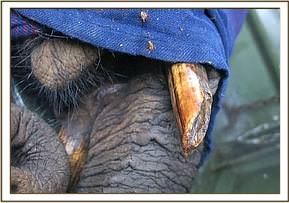
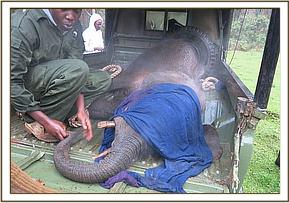

Injured Grevy zebra in Samburu national reserve
On 20th September 2013, wildlife scouts attached to the Grevy Zebra Trust (GZT) in West gate Samburu national reserve reported that a sub adult male gravy zebra showed lameness which required veterinary attention. The animal was immobilized for examination and treatment on 21st September.
Chemical immobilization
We used Etorphine Hcl 4mg and Xylazine 40mg in a 1.5 cc Dan-Inject dart with a 2.0 × 30 mm needle. Darting was conducted by vehicle with the dart was placed caudally on the left flank. Induction time (down time) was 8 minutes. On contact with the animal, opticlox ointment was applied on the dart wound and eyes to prevent desiccation of the cornea.
Vital parameters such as respiration and tissue perfusion were continuously monitored to ensure that the narcotized animal was stable.
After the procedure, Diprenophine 24 mg and Atipamezole 15mg were administered intravenously into the jugular vein to reverse the effects of etorphine and xylazine respectively.
Findings and prognosis
- Lameness on the right forelimb; swollen carpus
- Subluxation of the carpal joint
- infected wound on the skin around the fetlock joint with deep bite wound caudally
The traumatic wounds may have been caused by fight with other males; prognosis for recovery is good.
Treatment
- thorough wash with soap and water; dead tissue debrided and wounds irrigated with Betadine solution
- Green clay was applied on the wound
- 5% Flunixin meglumine 750mg deep intramuscular for pain management
- Betamox LA 20 milliliter deep intramuscular

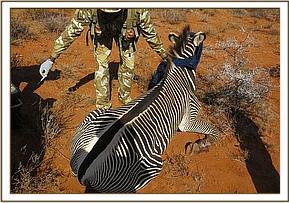
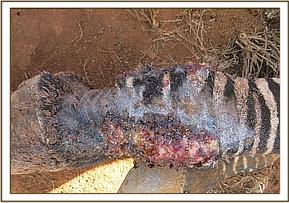
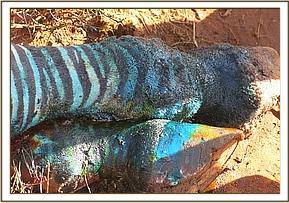

Snared lioness in Meru national park
On 24th September tour guides from Elsas Kopje reported a lioness with snare injuries around its neck.
The animal was immobilized with ketamine Hcl 30omg and Medetomidine Hcl 10mg in a single 3cc Daninject dart syringe. The dart was placed on the left gluteal muscle and induction time was 15 minutes.
Examination revealed that snare had fallen off, however, there were deep wounds caused by a snare around the neck and the medial aspect of the under arm.
Treatment
- wounds were thoroughly cleaned with savlon and betadine solution applied
- Betamox LA 20cc administered by deep intramuscular route
- Prognosis for recovery is good
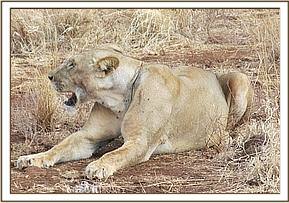
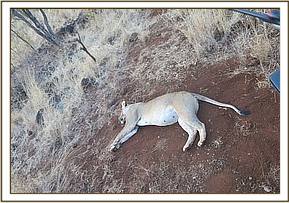
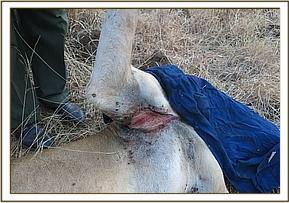

Injured white rhino in Meru national park
A 25 year old female white rhino and its 6 month old male calf were shot by suspected poachers in Meru NP on the night of 19th September.
The calf died instantly from gunshot injuries and a P.M examination performed with projectiles recovered in the dorsal processes of T3 vertebrae and the tarsal joint.
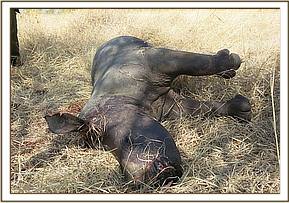

The dam which showed severe lameness was immobilized to examine the extent of injuries. Darting was conducted on foot. We used a combination of Etorphine Hcl 5mg and Xylazine Hcl 60mg in a single 1.5cc DanInject dart. After the procedure the animal was revived using a combination of Naltrexone 150mg and Antisedan 8mg administered intravenously.
Findings
- comminuted fracture of the radius at the left forelimb with severe loss of blood
- two penetrating gunshot wounds into the head dorsal to the left eye
- penetrating gunshot wounds into the left thorax
Because of these severe injuries euthanasia was recommended and approval was sought.
On post mortem examination projectiles were recovered in the frontal bones of the head. Shattered 10th rib with the bullets lodging in the ribs and the stomach.
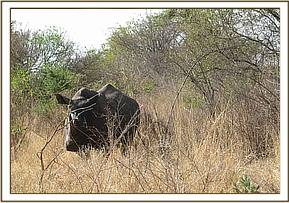
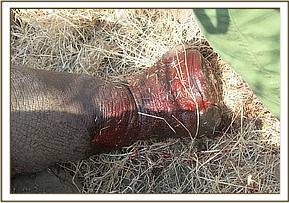



Post mortem examination of a white rhino carcass in Solio ranch
This was an adult female white rhino shot dead on the night of 20th September 2013 and both horns were poached.
A full post mortem was performed on the 22nd September to determine the cause of death and document forensic evidence.
There were four penetrating wounds into the right chest and head.
On opening the thorax, voluminous clotted blood, penetrating wound into the left lung and the heart.


Post mortem examination of an elephant carcass in Ol Pejeta Conservancy
On 28th September 2013, the security manager at Ol Pejeta conservancy reported a recumbent female elephant 20 – 25 years old in poor body condition which required urgent veterinary attention.
The animal died at night before we attended to it and a full post mortem was performed the following day.
The carcass showed severe emaciation, dehydration and anemia. Lungs were adherent to the thoracic wall attributed to pneumonia.
Both tusks were retrieved and deposited at Laikipia station armory for safe keeping.

Acknowledgements
We would like to thank the David Sheldrick Wildlife trust for providing financial and logistical support to the Meru mobile veterinary unit.
Report by: Dr. Bernard Rono